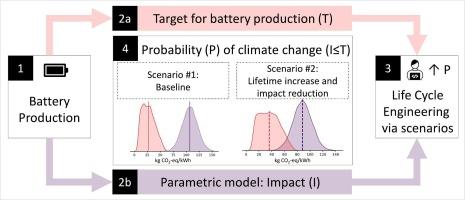锂离子电池绝对环境可持续性评价的参数化生命周期评价模型
IF 9.6
1区 环境科学与生态学
Q1 ENVIRONMENTAL STUDIES
引用次数: 0
摘要
最近的研究表明,包括气候变化在内的九个地球边界中的六个已经被超越。交通运输部门是气候变化的主要因素,使其脱碳具有挑战性。虽然电池电动汽车在使用阶段提供了相对的改进,但它们必须根据绝对的可持续性目标进行评估,并考虑到整个生命周期。针对NMC811电池组生产的绝对环境可持续性评估,建立了基于参数化建模的简化生命周期评估(LCA)模型。通过基于一阶Sobol指标的方差分解,构建了简化的LCA模型。将估计的气候变化影响与绝对可持续性目标进行比较,以确定实现这些目标的可能性。电池组的气候影响范围从第5百分位数的87.9 kg CO2-eq/kWh到第95百分位数的134.0 kg CO2-eq/kWh,平均值为108.0 kg CO2-eq/kWh。对于58千瓦时电池组,代表最大允许气候影响的平均气候变化目标值估计为27.25千克二氧化碳当量/千瓦时。将电池组的使用寿命从10-15年延长到15-25年,将目标值提高到36.20 kg CO2-eq/kWh。在电池生产中使用二次铝具有最大的减少气候变化影响的潜力。局部敏感性分析结果表明,使用100%二次铝可减少22.65%的气候变化影响。这也减少了对其他14个ReCiPe方法中点影响类别的影响。值得注意的是,“人类毒性:致癌”和“能源资源:不可再生化石”的影响分别减少了26.36%和19.73%。然而,“淡水生态毒性”和“陆地生态毒性”相关的影响分别增加了0.05%和0.68%。这项研究为电池生产领域的绝对可持续性做出了贡献。通过采用概率分析和参数化LCA建模,它可以评估具体的脱碳策略。本文章由计算机程序翻译,如有差异,请以英文原文为准。

Parametric life cycle assessment model for absolute environmental sustainability assessment of lithium-ion batteries
Recent studies indicate that six of the nine planetary boundaries, including climate change, have been exceeded. Decarbonizing the transport sector, a key contributor to climate change, is challenging. While battery electric vehicles offer relative improvements in the use stage, they must be evaluated against absolute sustainability targets, taking into account the entire life cycle. This study develops a simplified life cycle assessment (LCA) model based on parametric modelling for the absolute environmental sustainability assessment of NMC811 battery pack production. Simplified LCA models are constructed through variance decomposition based on first-order Sobol indices.
The estimated climate change impacts are compared against absolute sustainability targets to determine the probability of achieving them. Climate impacts for the battery pack range from 87.9 kg CO2-eq/kWh at the 5th percentile to 134.0 kg CO2-eq/kWh at the 95th percentile, with a mean value of 108.0 kg CO2-eq/kWh. The mean climate change target value, representing the maximum allowable climate impact, for a 58-kWh battery pack is estimated at 27.25 kg CO2-eq/kWh. Extending the battery pack's lifetime from 10–15 years to 15–25 years increases the target value to 36.20 kg CO2-eq/kWh. The use of secondary aluminium in battery production has the highest potential for reducing climate change impact. The results of the local sensitivity analysis indicate that using 100 % secondary aluminium reduces the climate change impact by 22.65 %. This also reduces the impacts in 14 other ReCiPe method midpoint impact categories. Notably the ‘human toxicity: carcinogenic’ and ‘energy resources: non-renewable, fossil’ impacts are reduced by 26.36 % and 19.73 % respectively. However, the impacts related to ‘ecotoxicity: freshwater’ and ‘ecotoxicity: terrestrial’ increase by 0.05 % and 0.68 % respectively.
This study contributes to the field of absolute sustainability within the context of battery production. By employing probabilistic analysis and parametric LCA modelling, it enables the evaluation of specific decarbonisation strategies.
求助全文
通过发布文献求助,成功后即可免费获取论文全文。
去求助
来源期刊

Sustainable Production and Consumption
Environmental Science-Environmental Engineering
CiteScore
17.40
自引率
7.40%
发文量
389
审稿时长
13 days
期刊介绍:
Sustainable production and consumption refers to the production and utilization of goods and services in a way that benefits society, is economically viable, and has minimal environmental impact throughout its entire lifespan. Our journal is dedicated to publishing top-notch interdisciplinary research and practical studies in this emerging field. We take a distinctive approach by examining the interplay between technology, consumption patterns, and policy to identify sustainable solutions for both production and consumption systems.
 求助内容:
求助内容: 应助结果提醒方式:
应助结果提醒方式:


